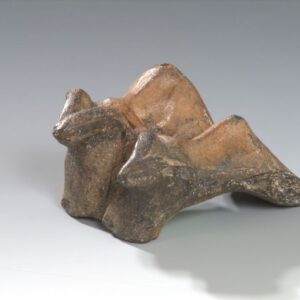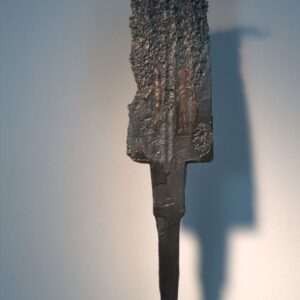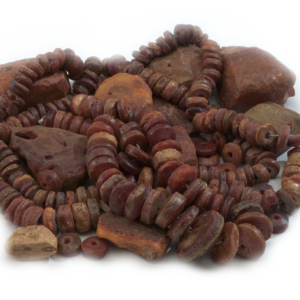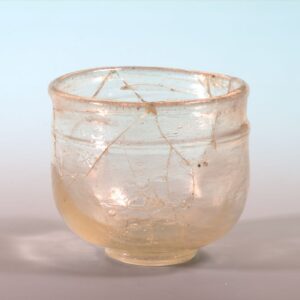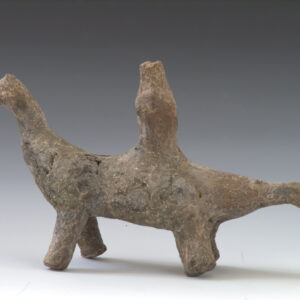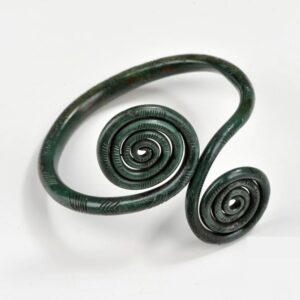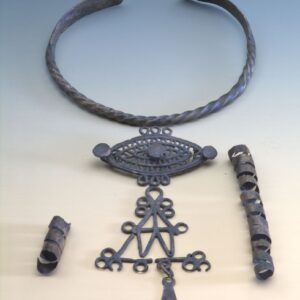The collection of post-1945 art at the Lublin Museum has been developed since the late 1950s. Although it does not form a systematically expanded collection, it reflects key artistic tendencies that define both the local and national dimensions of contemporary art in Poland.
The collection primarily consists of paintings and graphic works, currently housed in two sections of the Department of Art and Visual Culture. It highlights the main traditions of contemporary art, including:
- Colorist painting, represented by an extensive selection of works by Zenon Kononowicz, Władysław Filipiak, and Edward Nadulski.
- Modernist art, represented by the legacy of the “Zamek” group.
- Diverse nationwide artistic movements, broadly categorized under the concept of “metaphor.”
These three areas help illustrate the chronology and dynamics of contemporary artistic practices, including:
- The evolution of individual artists’ work, such as the modernization of colorism in the art of Filipiak and Kononowicz through abstraction.
- Transformations in the concept of painting, as seen in the works of Włodzimierz Borowski, Tytus Dzieduszycki-Sas, and Jan Ziemski.
- The coexistence of experimental approaches alongside traditional figurative art.
Since the 1970s, the collection has expanded to include works by major figures in Polish modern art, such as:
- Tadeusz Brzozowski, Marian Bogusz, Stefan Gierowski, Maria Jarema, Tadeusz Kantor, Jan Lebenstein, Jacek Sempoliński, Kajetan Sosnowski, Henryk Stażewski, Andrzej Wróblewski, and Jerzy Tchórzewski.
These artists embody the pluralism of abstraction and figuration, which emerged from Poland’s post-Stalinist artistic thaw.
The “Metaphor” project, initiated through plein-air workshops and exhibitions organized by the Museum, further expanded the collection. This allowed for the partial reflection of contemporary artistic themes, including:
- New Figuration, seen in the works of Maciej Bieniasz and Zbylut Grzywacz.
- Assemblages, particularly those by Władysław Hasior.
- Conceptual practices, such as “Collections” by Marian Warzecha and photomontages by Natalia LL and Andrzej Lachowicz.
This commitment to updating the collection is reinforced by the ongoing exhibition program featuring artists associated with the Faculty of Arts at Maria Curie-Skłodowska University in Lublin. These artists hold a significant place in the Polish art scene, and their works continue to enrich the Museum’s collection. Notable figures include:
- Jan Gryka, Ryszard Lis, Tomasz Zawadzki, and Jakub Ciężki.
The pre-war collection of the Lublin Museum Library was lost during World War II. Gathering of a new set began again in 1949, and in 1956 the Library became an independent department.
Nowadays, it gathers books, magazines, special collections (catalogues, guides to artefacts and museum exhibitions), photographs, cartographic issues and own publications. Their chronological range is wide – from old prints to 19th-century and contemporary prints. As a specialist institution, its collections include general literature on museology and special literature related to the nature of the museum.
Due to the funds from the European Union and the Lublin Voivodeship Government, the Library was modernised in 2010–2012.
People not employed by the Museum can access the collection only on site.
Decorative Arts in the Lublin Museum Collection
The decorative arts collection at the Lublin Museum comprises over 3,000 objects, including ceramics, glass, metalwork, textiles, and furniture.
A particular highlight is the extensive collection of antique porcelain from leading European and Polish manufactories. The European porcelain selection consists largely of 18th-century pieces from the early years of renowned manufactories such as Meissen, Berlin, and Vienna. Among these is a plate from the famous Swan Service.
Polish porcelain is represented primarily by pieces from the Volhynian manufactories of Korzec and Baranówka.
The collection also includes English, Dutch, German, and Polish faience, as well as rare stoneware from Lubartów, which is scarcely found in museum collections.
Among the metalwork, the most notable pieces include a curated collection of 19th-century Lublin silverware and a selection of valuable tile clocks.
The textile collection features several exceptional pieces, including:
- Sashes from the manufactories of Słuck, Kobyłka, and Lipków,
- A hussar lance pennant from the late 17th century,
- Several ornately embroidered chasubles from the 16th and 17th centuries.
The furniture collection includes several significant pieces, the most valuable being a chest and two Dutch cabinets from the 17th century.
Polish Painting
The painting collection of the Lublin Museum consists of over 1,600 works, primarily Polish paintings from the 17th to the 20th century, along with a small collection of European paintings. The origins of the collection date back to the pre-war period, but only a few works from that time remain, including paintings by Aleksander Kokular, Apoloniusz Kędzierski, Kazimierz Alchimowicz, and Louis de Silvestre.
After the war, the collection was rebuilt almost from scratch, aiming to present a comprehensive overview of Polish painting from the Baroque to contemporary times.
The 17th and 18th centuries are mainly represented by portraits. The oldest among them is a portrait of Queen Bona, displayed in a beautiful, original frame bearing the Sforza coat of arms. A large part of the collection consists of Sarmatian portraits, including depictions of figures associated with Lublin’s history, such as Adam Szaniawski (the Castellan of Lublin) and Kajetan Hryniewiecki (the last Voivode of Lublin in the First Polish Republic). The collection also includes a coffin portrait.
Examples of courtly portraiture include the Portrait of King Stanisław August Poniatowski in his coronation attire and the Portrait of Primate Michał Poniatowski, both from the workshop of Marcello Bacciarelli.
The 19th-century paintings, which are more numerous, document the evolution of Polish painting from Classicism through Romanticism to Realism. This section includes works by renowned portraitists such as Józef Pitschmann, Józef Reichan, Józef Simmler, and Kazimierz Kaniewski.
Landscape painting is represented by works of Ferdynand Lampi, Christian Breslauer, Antoni Malinowski, and Józef Brandt.
The historical painting genre includes:
- “Mohort on the Borderlands” by Juliusz Kossak,
- “Queen Jadwiga and Dymitr of Goraj” by Wojciech Gerson,
- “The Reception of Jews in Poland” by Jan Matejko.
Genre painting is relatively scarce but includes works by Zygmunt Ajdukiewicz, Franciszek Kostrzewski, and Henryk Lipiński.
The late 19th century is represented by artists such as Jacek Malczewski, Jan Stanisławski, Leon Wyczółkowski, Kazimierz Krzyżanowski, Olga Boznańska, and Apoloniusz Kędzierski.
The 20th-century paintings form the largest part of the collection, accounting for over 70% of the total holdings. Though not a cohesive collection, it features a broad selection of leading Polish artists representing various movements, including:
- Tytus Czyżewski, Tymon Niesiołowski, Rafał Malczewski, Tadeusz Makowski, Eugeniusz Zak, Henryk Stażewski, Władysław Strzemiński, Roman Kramsztyk, Jerzy Nowosielski, Władysław Hasior, Tadeusz Kantor, Kazimierz Mikulski, Andrzej Wróblewski, Zygmunt Waliszewski, Erna Rosenstein, Jan Lebenstein.
A significant part of the 20th-century collection consists of paintings by artists from Lublin, including Zbigniew Kononowicz, Jerzy Karmański, Wacław Filipiak, Jan Ziemski, Tytus Dzieduszycki, Władysław Borowski, Ryszard Lis, Jerzy Popek, and Tadeusz Kawiak.
Since 1976, the museum has organized the “Metaphor” national theoretical and artistic meetings, resulting in a collection of works by Erna Rosenstein, Henryk Waniek, Natalia Lach-Lachowicz, Andrzej Dłużniewski, and Andrzej Kołpanowicz.
Foreign Painting
The foreign painting collection comprises approximately 80 works and does not form a cohesive collection. It includes Dutch, Flemish, and Italian paintings, as well as a few French, German, and Austrian works.
The most valuable painting in the collection is “Pontius Pilate Washing His Hands” by Hendrick ter Brugghen, painted around 1617.
Other notable works include:
- “Dog Fight with Foxes” by Abraham Hondius,
- “Still Life with Jug and Candle” by Hendrick Heemskerck,
- “Mocking” by Frans Francken II,
- “Concert”, painted by an unknown artist from the Caravaggio school,
- “Adoration of the Magi” by Michael Leopold Lukas Willmann,
- “Mountain Landscape” by Johann Christian Brand
W związku z powstaniem w Lublinie w latach 60. XX w. Muzeum Wsi Lubelskiej i udostępnieniem ekspozycji z zakresu kultury materialnej, w 1984 r. Muzeum Lubelskie ograniczyło gromadzenie zbiorów etnograficznych do sztuki ludowej. Uzupełniało kolekcje z zakresu rzeźby, malarstwa, plastyki obrzędowej, artystycznego kowalstwa, itp. Od 1952 r. do chwili obecnej prowadzona jest systematyczna akcja gromadzenia eksponatów.
Mimo, że od lat 80. XX w. gromadzenie zabytków ogranicza się do eksponatów z zakresu sztuki ludowej, to w zbiorach znajdują się również obiekty z zakresu kultury materialnej. Są to m.in.: socha drewniana, brony laskowe, dłubane czółna, unikalne narzędzia rybackie. Zbiory z poszczególnych dziedzin kultury ludowej uzupełniane były poprzez organizowanie wystaw monograficznych, dotyczących określonych działów. W wyniku tych wystaw powstały prawie pełne kolekcje z następujących dziedzin: strojów, plastyki obrzędowej, tkactwa, garncarstwa, plecionkarstwa, rybołówstwa i sitarstwa.
Około 60% zbiorów pochodzi z XIX i początków XX w. Do najstarszych datowanych eksponatów, których metryka wywodzi się z XVII i XVIII w. należy kilka brokatowych gorsetów tarnogrodzkich, XVII-wieczna forma do robienia opłatków oraz laska sołtysia z 1780 r. Unikatowe także są liry dziadowskie. Z tego okresu w zbiorach znajduje się ok. 60 rzeźb: przedstawiających postać Chrystusa Frasobliwego, Chrystusa Ukrzyżowanego i innych świętych (Matki Boskiej, Chrystusa Króla, św. Jana Nepomucena, św. Jana, św. Jana Kantego, św. Józefa, św. Antoniego, św. Katarzyny). Gdy większość z nich jest nieznanego autorstwa, to jednak na szczególną uwagę zasługuje fakt, że kilka rzeźb to prace świątkarzy działających w XIX w. znanych z imienia i nazwiska. To: Mikołaj Gomiela z w pow. biłgorajskiego, Jan Kaproń z Krzemienia w pow. janowskim, Józef Kwiatkowski z okolic Łęcznej i Józef Zagórski z okolic Hrubieszowa. Wszystkie rzeźby wyróżniają się wysokim poziomem artystyczny i dużą oryginalnością. Prawdopodobnie eksponatów z przełomu XIX i XX w. jest znacznie więcej, ale z uwagi, że dokumentacja zbiorów w początkach istnienia muzeum była prowadzona dość dowolnie, trudno jest obecnie to ustalić.
The collection of the Graphic Art and Drawings Section, separated in 1975 from the former Art Department, is one of the most numerous sets of the National Museum in Lublin. They include over 10,000 exhibits on paper by Polish and foreign artists, which were created from the 17th century to modern times. They include graphics, drawings, watercolours, pastels, as well as graphic matrices.
The extensive complex of objects consists of views of Lublin and the Lublin region, which are valuable iconographic material for sources of knowledge about the past of the city and the region, both in the architectural, topographic and social sense. The oldest objects are the 17th and 18th century engravings with views of Lublin by A. Hogenberg, G. Bodenehr and J. Maszewski. Among the 19th-century images of the city, graphics by L. Urmowski, L. Horwart, and A. Lerue deserve attention. In the 19th and early 20th centuries, Lublin and the region were portrayed by, among others: M. E. Andriolli, J. Chełmoński, F. K. Dietrich, W. Gerson, A. Gierymski, L. Wyczółkowski.
In the collection of an iconographic nature, representative images of historical figures by, among others, S. della Bella, K. de La Haye, J. Falck, J. F. Piwarski, deserve attention.
The extensive group of works consists of collections of graphics and drawings from the end of the 19th and 20th centuries, which reflect various tendencies and styles of artistic imaging, ranging from pencil sketches by J. Matejko, J. Brandt and W. Czachórski, through watercolour studies by P. Michałowski, sketches and graphics by J. Pankiewicz, to an extensive collection of works by Young Polish artists – T. Axentowicz, J. Fałat, K. Sichulski, S. Wyspiański, L. Wyczółkowski, S. I. Witkiewicz.
The presence of the most outstanding Polish contemporary graphic artists in the museum’s collection was significantly expanded thanks to the donation of I. Hochman and the Lublin-based artist T. Mysłowski, who donated to the Museum an extensive collection of works depicting important phenomena in Polish and world graphics in the 20th and 21st centuries.
Biographical and Literary Collections
Bolesław Prus Museum in Nałęczów
The events of World War II irreversibly destroyed most of the collection that Oktawia Głowacka, the wife of Bolesław Prus, had donated to public institutions after the writer’s death. For sixty years, the museum bearing his name has been gathering memorabilia related to the life and work of the author of The Doll.
The institution’s collection includes unique photographs from the Głowacki family album, original letters from the writer and his wife, postcards, manuscripts, and typescripts of his works. Of particular note is the rich collection of illustrations for Prus’s works, especially a series of graphics by Edward Okuń for Pharaoh. These were created in 1914, after the artist had traveled to Egypt to capture the atmosphere of the ancient world as accurately as possible. However, the outbreak of World War I disrupted the publishing plans of Gebethner and Wolff, and as a result, the first (and only) edition of Pharaoh with Okuń’s illustrations was published a hundred years later.
The museum’s library, which contains over two thousand volumes, includes books that once belonged to Prus, proof copies and first editions of his works, as well as translations of his writings—even into more exotic languages, such as Chinese, Korean, Japanese, Armenian, Finnish, and Esperanto. The most interesting volumes from the museum’s collection are displayed in the writer’s study.
Bolesław Prus’s glasses, his ivory letter opener, a nameplate from the door of his Warsaw apartment, and two 19th-century typewriters are just some of the items on display in the permanent exhibition. Meanwhile, the institution’s archive holds a rich collection of bookplates, as well as documents and photographs that provide insight not only into the life and work of our Patron but also into the history of Nałęczów.
Collections of the Stefan Żeromski Museum in Nałęczów
The museum houses the authentic furnishings of the writer’s former study, including a sofa, chairs, and armchairs, with a bed located behind a screen. Żeromski’s desk, which he used in Warsaw while writing Ashes, remains intact, along with his personal library. A display cabinet features schoolbooks, notebooks, writing tools, travel souvenirs, and numerous drawings by Adam Żeromski.
The museum also exhibits Adam Żeromski’s school materials, travel souvenirs, drawings, skis, and ice axes. A significant highlight is the collection of portraits of Stefan Żeromski, created by renowned artists such as Stanisław Ignacy Witkiewicz, Eligiusz Niewiadomski, Tadeusz Pruszkowski, Michał Bojczuk (Ukraine), Tymon Niesiołowski, and Franciszek Siedlecki. Additionally, portraits of Adam Żeromski by Leon Wyczółkowski, Kazimierz Młodzianowski, and Michał Bojczuk are on display. The museum also holds sculpted relief portraits of Żeromski by Czesław Makowski and Stanisław Ostrowski.
Further notable pieces include sketches and drawings by Stanisław Witkiewicz and Witkacy, architectural designs by Jan Witkiewicz, works by Henryk Siemiradzki, Stanisław Noakowski, and Jan Stanisławski, as well as landscape compositions by Oktawia Żeromska. The museum even possesses two paintings by Stefan Żeromski himself: View from the Chata Window and an illustration for his short story The Crows and Ravens Will Peck Us to Pieces.
The collection also features documents related to the activities of the Światło Educational Society, the construction of an orphanage, and an extensive collection of letters from Stefan, Oktawia, and Adam Żeromski. The exhibition is enriched by various keepsakes, family photographs from different periods of the writer’s life, and personal memorabilia.
Collections of the Józef Czechowicz Literary Branch
The museum has successfully gathered the majority of Józef Czechowicz’s dispersed manuscript legacy, including original literary works, numerous letters to friends and family, photographs, and biographical documents such as diary fragments, school certificates, a diploma from the Institute of Special Education in Warsaw, and materials related to the activities of the Lublin Writers’ Association.
Additionally, the museum holds an extensive collection of manuscripts from other authors connected to the Lublin region, including Franciszka Arnsztajnowa, Konrad Bielski, Wacław Gralewski, Kazimierz Andrzej Jaworski, Antoni Madej, Bronisław Ludwik Michalski, Jerzy Pleśniarowicz, Wacław Mrozowski, Józef Nikodem Kłosowski, Józef Łobodowski, Maria Bechczyc-Rudnicka, Stanisław Bojarczuk, Jan Pock, and Anna Kamieńska.
The museum also preserves letters and manuscript works by some of Poland’s most distinguished poets, such as Czesław Miłosz, Wisława Szymborska, Zbigniew Herbert, Jerzy Zagórski, Julian Tuwim, and Konstanty Ildefons Gałczyński.
A particularly valuable part of the collection includes an extensive photographic documentation of Lublin’s literary life, a rich library of approximately ten thousand volumes, an archive of historical periodicals, recordings, memorabilia, and commemorative prints.
Collection of the Numismatics Section of the National Museum in Lublin consists of over 62,000 items. The most numerous items are coins – over 56,000, from ancient to modern, with a predominance of modern issues, especially Polish ones. The nearly 4,500 objects of medal art include the oldest, 16th and 17th-century Polish medals (the former as 19th-century collector’s copies), an interesting collection of medals from the 18th century and a rich representation of 19th and 20th-century national medals. The collection of nearly 1,900 paper money items consists mainly of Polish banknotes and securities, from the oldest banknotes of the Kościuszko Uprising of 1794, to the contemporary issues of the Bank of Poland. The sigillographic collection consists of 269 pistons and stamps of seals, the oldest of which have a medieval record.
The numismatic collection of the National Museum in Lublin is one of the most important in the country.
The collection consists of approximately 3,500 exhibits of both Polish and foreign origin, representing offensive and defensive weaponry, uniforms, military equipment, badges and decorations, cavalry gear, historical horse tack elements, and military documents. These artifacts are housed in the Militaria Department as well as in the Regional Museum in Kraśnik (24th Uhlan Regiment Museum).
The Archaeology Section (until 2015 the Archaeology Department) collects material culture relics documenting the most ancient history and life of human communities in the area between the Vistula and the Bug rivers from the Paleolithic to the early Middle Ages. It conducts its own field research, organised with the participation of the Voivodeship Office for the Protection of Monuments in Lublin.
The archaeological collection of the Archaeology Section of the National Museum in Lublin consists of over 40,000 of its own monuments and 78,000 deposited by the Voivodeship conservator of monuments in Lublin. The first excavations on behalf of the Lublin Museum were carried out in 1951.
In the research work carried out so far, the source base for learning about the prehistory, medieval and modern times of our region has been enormously enriched in both quantitative and qualitative terms. Among the historic artefacts dated from the Middle Palaeolithic to modern times, apart from the museum objects obtained during excavation works carried out by archaeologists from the Museum, one can find artefacts from the research carried out by archaeological conservators, monuments conservation worhskops in Lublin, the Institute of Archaeology of the Maria Curie-Skłodowska University, and recently objects provided by private archaeological companies operating in the Lublin region. The collections of the Archaeology Section is constantly enriched by relics discovered by chance.
The exhibits collected represent all prehistoric cultures. In addition to ceramics, the most numerous in the cultural inventory, the collection includes tools and weapons made of stone, metal, bones and horns; shell, bone, copper, bronze, iron, faience, glass and gold ornaments, as well as numismatic items. The archaeological section also stores documentation from field research and houses a photographic archive.
|
|
|
|
